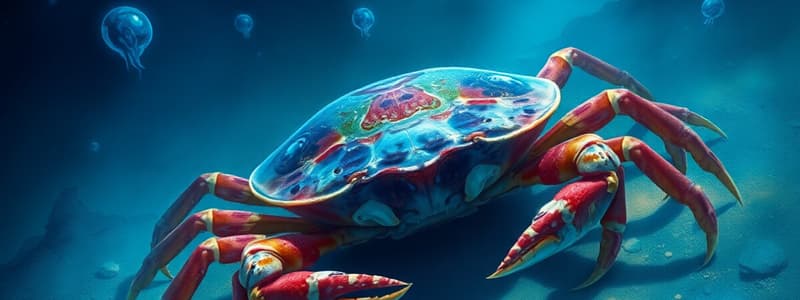Podcast
Questions and Answers
Why is the LAL test crucial in the final phase before vaccine distribution?
Why is the LAL test crucial in the final phase before vaccine distribution?
- To identify any potential allergic reactions in patients.
- To ensure the vaccine is stored at the correct temperature during transport.
- To detect the presence of harmful endotoxins that may have contaminated the vaccine. (correct)
- To determine the effectiveness of the produced vaccine.
What is a key difference between human blood and horseshoe crab blood?
What is a key difference between human blood and horseshoe crab blood?
- Human blood clots in the presence of endotoxins, while horseshoe crab blood does not.
- Human blood has iron as its oxygen carrier and is red, while horseshoe crab blood has copper as its oxygen carrier and is blue. (correct)
- Human blood has a copper-based oxygen carrier that is blue, while horseshoe crab blood has an iron-based oxygen carrier that is red.
- Human blood uses amebocytes to fight infection, while horseshoe crab blood uses white blood cells.
What is a significant ecological consequence of harvesting horseshoe crabs for their blood?
What is a significant ecological consequence of harvesting horseshoe crabs for their blood?
- Disruption of the migratory patterns of birds, such as the Red Knot, that depend on horseshoe crab eggs. (correct)
- Increased success in breeding rates of other crab species.
- Decreased algae blooms in coastal areas.
- Increased shark populations due to the removal of a key food source.
Why are sustainable harvesting protocols important for horseshoe crabs?
Why are sustainable harvesting protocols important for horseshoe crabs?
What challenge exists in replacing horseshoe crab blood with a synthetic substance?
What challenge exists in replacing horseshoe crab blood with a synthetic substance?
Which method of harvesting horseshoe crabs is least preferred due to its impact on other marine life?
Which method of harvesting horseshoe crabs is least preferred due to its impact on other marine life?
Estimate the number of horseshoe crabs that would likely die if 250,000 are harvested in a season, given the mortality rate?
Estimate the number of horseshoe crabs that would likely die if 250,000 are harvested in a season, given the mortality rate?
Why is the blood of horseshoe crabs blue, unlike human blood which is red?
Why is the blood of horseshoe crabs blue, unlike human blood which is red?
What characteristic of horseshoe crabs contributes significantly to their survival as a species for millions of years?
What characteristic of horseshoe crabs contributes significantly to their survival as a species for millions of years?
How does limulus amebocyte lysate (LAL) from horseshoe crab blood contribute to the safety of vaccines?
How does limulus amebocyte lysate (LAL) from horseshoe crab blood contribute to the safety of vaccines?
Which of the following species of horseshoe crab is found in North and South America?
Which of the following species of horseshoe crab is found in North and South America?
Considering their evolutionary history, why are horseshoe crabs referred to as 'living fossils'?
Considering their evolutionary history, why are horseshoe crabs referred to as 'living fossils'?
How does hemocyanin in horseshoe crab blood facilitate oxygen transport, and what element is central to this process?
How does hemocyanin in horseshoe crab blood facilitate oxygen transport, and what element is central to this process?
If a new species of horseshoe crab were discovered, inhabiting coastal regions, in which geographic location would it most likely be found?
If a new species of horseshoe crab were discovered, inhabiting coastal regions, in which geographic location would it most likely be found?
Why is it crucial to test vaccines for sterility using limulus amebocyte lysate (LAL) before they are administered to humans?
Why is it crucial to test vaccines for sterility using limulus amebocyte lysate (LAL) before they are administered to humans?
Flashcards
LAL Test
LAL Test
A test using horseshoe crab blood to detect endotoxins in vaccines.
Dredging
Dredging
Dragging a net along the ocean floor to collect marine organisms, including horseshoe crabs.
Hand Collection
Hand Collection
Harvesting horseshoe crabs by hand during their mating season on beaches.
Amount of blood extracted during harvesting
Amount of blood extracted during harvesting
Signup and view all the flashcards
Red Knot
Red Knot
Signup and view all the flashcards
Horseshoe Crab Blood Cost
Horseshoe Crab Blood Cost
Signup and view all the flashcards
Horseshoe Crab Harvesting
Horseshoe Crab Harvesting
Signup and view all the flashcards
Living Fossil
Living Fossil
Signup and view all the flashcards
Exoskeleton
Exoskeleton
Signup and view all the flashcards
Arachnids
Arachnids
Signup and view all the flashcards
Horseshoe Crab Regions
Horseshoe Crab Regions
Signup and view all the flashcards
Hemocyanin
Hemocyanin
Signup and view all the flashcards
Limulus Amebocyte Lysate (LAL)
Limulus Amebocyte Lysate (LAL)
Signup and view all the flashcards
Endotoxin
Endotoxin
Signup and view all the flashcards
Hemoglobin
Hemoglobin
Signup and view all the flashcards
Study Notes
- Horseshoe crabs possess blue blood with significant medical applications for humans.
Ancient Species
- Horseshoe crabs, dubbed "living fossils," have retained their body plan and behavior for 445 million years.
- They predate dinosaurs and have survived major extinctions.
- Their thick exoskeleton protects them from predators.
- Their blue blood has antibacterial properties.
Classification and Habitat
- Horseshoe crabs are closer to arachnids than crabs.
- Four species exist, inhabiting coastal ocean regions.
- They come onto land to spawn and lay eggs.
- Species and Regions:
- Tachypleus gigas: South Asia
- Tachypleus tridentatus: South Asia
- Carcinoscorpius rotundicauda: South Asia
- Limulus polyphemus: North & South America
Blue Blood
- Horseshoe crab blood is blue due to hemocyanin, which contains copper.
- Human blood uses hemoglobin, which contains iron, giving it a red color.
- The medical community is particularly interested in limulus amebocyte lysate (LAL) found in horseshoe crab blood.
Medical Uses
- LAL, found in horseshoe crab blood is used to test vaccines for sterility.
- The LAL test detects endotoxins from bacteria.
- The LAL test was developed in the early 1960's and approved in the 1970's.
- All vaccinations undergo LAL testing before FDA approval.
- No synthetic substitute is as effective as horseshoe crab blood, so harvesting continues.
Harvesting
- Two methods are used:
- Dredging: A net is dragged along the ocean floor.
- Hand collection: Animals are caught by hand during mating season.
- Protocol:
- Collect animals via dredge or hand.
- Transport to lab for bleeding.
- Collect 30% of blood.
- Release crabs or bleed fully to sell as bait.
Costs
- Horseshoe crab blood is expensive, potentially exceeding $15,000 per quart.
- The FDA enforces sustainable harvesting protocols.
- There is a 10%-15% mortality rate for harvested horseshoe crabs.
- Horseshoe crab eggs are important for migratory birds, especially the endangered Red Knot.
- Red Knot populations have declined with horseshoe crab populations, especially in the 1980s and 1990s.
Studying That Suits You
Use AI to generate personalized quizzes and flashcards to suit your learning preferences.




